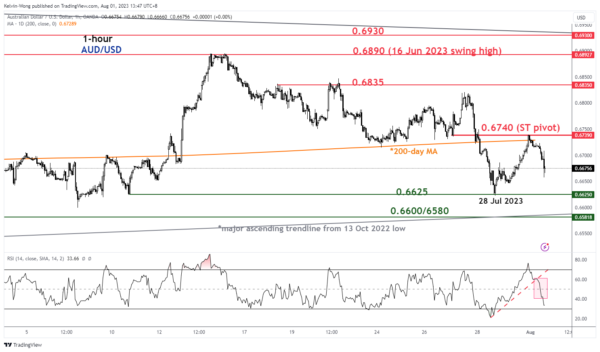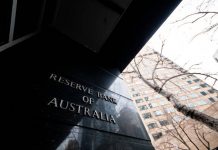- Australia’s central bank, RBA has kept its policy cash rate unchanged at 4.1% for the second consecutive month.
- The tonality of the latest monetary policy implies that RBA is now data-dependent, and indirectly acknowledged the negative adverse lagged effects of higher interest rates towards economic growth.
- Overall, RBA may continue to remain on hold on its policy cash rate at 4.1% for the rest of 2023 which in turn negates any potential major bullish movement of the AUD/USD.
Expectations of interest rates traders were right in line with the Australian central bank, RBA’s latest monetary policy decision (no interest rate hike today) that was in contrast to the 25-basis points hike consensus from the majority of the economists surveyed.
RBA has decided to hold on to its official policy cash rate at 4.1% for the second consecutive month; data from the ASX 30-day interbank cash rate futures as of 31 July 2023 has indicated a patty pricing of only a 14% chance of a 25-bps hike, down significantly from a 41% chance being priced a week ago.
These are the key takeaways from today’s RBA monetary policy statement;
The Board has decided to hold the interest rate steady this month to access the impact of the prior rate increases and monitor the economic outlook.
Risk of below-trend growth for the Australian economy due to weak household consumption growth and dwelling investment.
The labour market has remained tight, with job vacancies and postings at high levels, though labour shortages have lessened. But the unemployment rate is expected to rise gradually from 3.5% to around 4.5% in late 2024.
Even though wage growth has picked up due to the tight labour market and high inflation but wage growth, together with productivity growth remains consistent with the inflation target.
The current growth rate of 6% inflation in Australia is still considered too high. The central forecast expects CPI inflation will decline to around 3.5% by the end of 2024 and revert to the target range of 2% to 3% by late 2025.
The Board may consider further tightening of monetary policy to ensure inflation returns to the target range of 2% to 3% depending on data and evolving risk assessments.
Switched to being “data-dependent” suggests RBA may stand pat on interest rates till end of 2023
The last point as mentioned above stood up starkly, in the previous July’s monetary policy statement, it was noted as “some further tightening of monetary policy may be required to ensure that inflation returns to target in a reasonable timeframe, but that will depend upon how the economy and inflation evolve”.
In today’s monetary policy, it has been stated as “that will depend upon the data and the evolving assessment of risks”. Hence, this latest framing of being data-dependent, and acknowledging the implied negative adverse lagged effects of a higher interest rate environment towards economic growth (risk assessment) seems to portray that if the recent trend of key economic indicators continues their respective trajectories, it is likely the RBA may continue to remain on hold on its policy cash rate at 4.1% for the rest of 2023 while monitoring the global inflationary environment.
Lacklustre sentiment for AUD/USD
AUD/USD minor short-term trend as of 1 Aug 2023 (Source: TradingView, click to enlarge chart)
A “data-dependent” RBA has knocked out the bullish tone of AUD/USD after a reprieve rebound seen yesterday, 31 July where the pair staged a minor rebound of 117 pips from its last Friday, 28 July intraday low of 0.6622 to an intraday high of 0.6739 during yesterday’s US session.
Right now, it has shed -81 pips to print a current intraday low of 0.6657 at this time of the writing, and the Aussie is the worst performer intraday today, 1 Aug (-0.65%) among the major currencies against the US dollar; EUR (-0.03%), CHF (-0.03%), GBP (-0.07%), CAD (-0.22%), and JPY, (-0.34%).
The Aussie has resumed its underperformance against the US dollar seen in the last two trading days of last week where the AUD/USD recorded an accumulated loss of -1.68% from 27 July to 28 July versus EUR/USD (-0.63%), GBP/USD (-0.71%), and JPY/USD (-0.65%) over the same period ex-post FOMC, ECB, and BoJ.
From a technical analysis standpoint, short-term bearish momentum remains intact as yesterday’s rebound has failed to surpass the 200-day moving average after a re-test on it, now acting as a key short-term pivotal resistance at around 0.6740 with the next major support coming in at 0.6600/6580.













